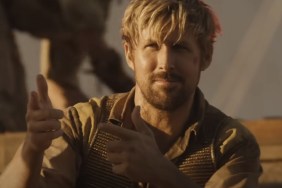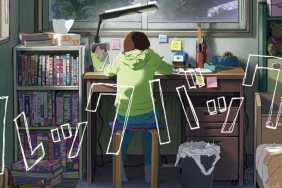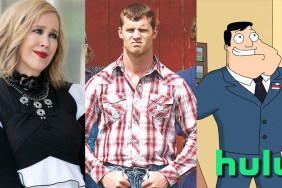A couple of weeks back, ComingSoon.net was invited to the White Plains, New York offices of Blue Sky Studios for a look at the inner workings of how they turned the Dr. Seuss classic Horton Hears a Who! into the computer animated family film released by 20th Century Fox this past March. With the DVD hitting shelves next week, it was a good time to revisit the movie which features Jim Carrey as the voice of an elephant named Horton who discovers a miniature world of tiny creatures called Whoville within a clover. Steve Carell provides the voice of the Mayor of Whoville while Carol Burnett voices Horton’s chief detractor, a kangaroo.
One of the film’s two directors, Steve Martino, gave us a special hour-long presentation going through every aspect of making the film from development through recording the various actors’ voices and working on the score with composer John Powell. Starting with the very first early steps of design and development, it was a great tutorial in how a big budget computer animated film is produced from the ground up.
One thing that was very clear to Martino and his directing partner Jim Hayward from the very early days of the project four years ago was that Dr. Seuss himself would be their production designer, so they spent a lot of time studying the artist’s work, not just in the children’s book on which the movie is based but also some of his sculptures and paintings and letters Seuss wrote to Chuck Jones (animator of the original “How the Grinch Stole Christmas” cartoon). The first thing they did with art director Tom Cardone was they created a style guide for the 300 animators working on the film which gives them an idea of the vision. They studied Seuss’ artwork very careful to find some of the recurring things he used, and tried to incorporate them into the design of the characters and the city of Whoville. Martino showed a lot of slides with examples of how those elements were incorporated into their designs, avoiding straight lines to use lots of bends and wrinkles, which isn’t the most natural way computer animation is generally used. They decided to use odd materials and textures to create the buildings of Whoville and even created something called the “Seussometer” to determine whether they were on the right track with everything they were doing during the design process.
Then they got into the design of the characters including Horton himself, who Martino noted looked different on every page of Seuss’ book, but they wanted to make Horton even more flexible to match the elasticity of Jim Carrey, the actor voicing him, so they decided very early to incorporate a process called “squash and stretch” to make that feasible. The design team also had literally hundreds of Whos to design and dress, and had a lot of fun with the Mayor of Whoville’s 96 daughters, each who had to have their own personality, style and fashion sense.
Once they had the design and script in place and had recorded the various voice actors–who also brought their own dimension and personalities to each of their characters–they started working with the animators, working out each scene in a process they call “Sweat Box” where the animators pitch ideas for various scenes with 24 hours to conceptualize them, some of them even putting themselves on film to act out what they think might work. Martino talked about how various characters like Horton’s bashful secret admirer Katie were developed by the creative animators of Blue Sky and then given more screen time because they became so popular. Then the scenes are broken up and distributed among the animators who start creating them. The next step involves fleshing out the characters and scenes using lighting and fur and textures and how the FX team creates things like water and wind for some of the bigger scenes.
Another interesting bit that Martino went through was showing how composer John Powell created the climactic final sequence where the residents of Whoville come together to create enough noise to be heard by those in the outside world, and all of that was orchestrated and synchronized using a click track to allow all the noises being created to be very musical, so that the music could drive the action.
After the presentation was over, CS had a chance for a quick interview with Martino to talk about some of the things not covered in the presentation:

ComingSoon.net: I’ve spoken to a few animation directors and co-directors and you really seem to have a grasp on every single aspect of the process although you came more from the art side of it. How do you end up learning the rest of it and as a director, is it a matter of finding the right team?
Steve Martino: I think it’s different for every person. I came up through computer animation in its infancy, so when I first started, I storyboarded and then I’d go in and model and animate and light and render. Back in the early days of this technology, we weren’t so specialized so I had to learn, and I wasn’t good at all those. I kind of fumbled my way through, especially the technical side, so I had an understanding of all of the various components that come into making a film like this. Through my career, I’ve realized that my strengths seem to be more on the visual side, so as Jimmy Hayward, my directing partner, and I worked together on “Horton,” Jimmy came from Pixar, was an animator, so his focus and specialty is animation and story, my speciality is lighting, texture, art direction and then what we do is we stay together in the process. Editorial we do together, animation, in “sweat box” when we see the first animation coming up, we do that together, but then through the rest of a normal day for us, we might split off and I’ll spend a little extra time with the design group or materials or fur, and he might give an extra set of rounds to animators. We always had to be on the same page with the story and the editing of the movie, but the little details, especially at the height of production when you have close to 300 people working on it at the same time, you got a lot of eyeballs who want your attention, so that’s how we would divide up the work.
CS: As far as being an animation director, do you think it’s most important to be able to understand and work with all the different departments? What’s the most important thing as far as being able to move up from the animation pool to direct movies?
Martino: I think, in terms of being a director, one of the major changes is an ability to communicate a vision for what you’re trying to do, because in directing a movie, you’re not doing anything hands on. I rarely picked up a pencil other than in my sketchbook to jot something down. When I was art directing, I would always have projects that I was always designing something or working something out. In directing, it’s a matter of creating a vision for the storytelling and how that permeates its way through a decision on the color of the material on a stone wall vs. how an animator is going to create a pose for a particular moment of a character. You need to be the ultimate filter of that story through all of these different components, so it’s a matter of communicating that vision and being receptive to other people plussing that idea.
CS: It’s such a collaborative process and so many people involved, so does the director keep the adage about “too many cooks spoiling the batter” from happening?
Martino: Yeah, I think ultimately, you have to consolidate that decision that we’re going to base a decision on the theme of the book and that is what we’re going to stick by. Jimmy and I had to come together and it’s interesting: Jimmy and I are two totally different personalities but when it came to this story, we had very, very similar thinking about how we wanted to tell the story, what we wanted to see in the characters and we had to be in locked step on that because once you get rolling, I liken it to a roller coaster, it starts rolling downhill and you want to have it pointed in the right direction. Otherwise, you can burn up tons of time and tons of energy.
CS: You obviously have a great production designer in Dr. Seuss himself. His history in film, there were the 2D animated films from the ’60s, then they started doing the live action films. Why do you think it’s taken this long to make the move to 3D animation? Do you have any theories on that?
Martino: You know, I don’t have the full answer. I do know that as we sat with Audrey Geisel and a couple of people she works with and we showed some of our first tests and said, “This is where we’re going with the movie. These are the things we can do in animation.” They looked to one another and said, “Wow, we should have done these in animation from the start.” Of course, I’m like, “Well, yeah, sure!” because that’s what I work in, but I remember when Dr. Seuss passed away, I think it was 1991, and I was working in computer animation and our technology was just getting to that place. I think “Toy Story” was in production–I don’t think it had come out yet–but our capabilities were finally to a place where we could tell a story like this and I thought, “Wow, a Dr. Seuss world in computer animation could be so cool.” We can make you believe that something’s a little more real than hand-drawn in terms of texture and lighting and so forth, but we can do that same kind of exaggerated movement that I think his books and his imagination always suggested to me.

CS: When you talk about other animation studios, someone like Pixar almost always goes for the realism, but here, you’re definitely going more for the 2D thing, inspired by Chuck Jones and the “squash and stretch” and when I talked to the guys who did “Madagascar,” they were also going for that same thing. Why do you think there’s this desire when you have the ability to go for realism to try to go back and recapture parts of what made those 2D cartoons so fun?
Martino: I think its just the next step. At first, you’re trying to make characters feel like they’re alive. A lot of stories call for the characters to be more true to their materials and true to their form, but animators are exaggerated actors and they love to push. You can find great humor and you can find an accentuation of the moment. We’re all students of animation history. We grew up on… Chuck Jones’ “The Grinch” is one of my all-time favorite works, and it’s because of the way he’s staged, and I looked at the way he’d stage his action, the way he’d cut and edit but also the way it was animated. Not every story fits. This story seemed to fit that animation style and our animators, man, they just jumped in and they had a blast with it. It was harder work but they did it with a smile on their face, ’cause they were kind of pushing new ground for them.
CS: I wonder if the animator Jeff Gabor knew that you were going to be showing us the footage of him acting out the scenes.
Martino: I told him! He’s wonderful, he’s a phenomenal actor. A lot of the other animators would use him to do their performance, because he’s a good physical actor himself and not all animators have that physical ability, at least in our computer animation style. Some of them are phenomenal when they get the character on the screen, but they probably couldn’t act their way out of a paper bag.
CS: You’ve been working on this movie for four years, and in this country at least, Blue Sky is one of the three main animation houses along with Pixar and DreamWorks, so how does things being done by other studios affect what you’re doing when you work on a movie like this for so long and see what others are doing?
Martino: They push us. We see a Pixar movie come out and we’re in the middle of production on ours and it’s like look, the bar is high. It’s inspiring to us, it makes us buckle down and put every little bit of juice we can into the work up on the screen. It’s interesting. I spent time with the two directors on “Kung Fu Panda” and it was ironic, because we had a 2D dream or imagination sequence in our film, so did they. There were a number of things, and it’s not like we’re out copying off another. We’re making our own stories and the only thing I can say is that I was happy that ours came out first. Their film was a wonderful film. It’s well-crafted and well done but it’s interesting that they probably had that reaction when they saw ours hit the screen, it was like, “Oh, man! Why did they get that out there first?”
CS: Where do you go from here? Obviously, directing a movie based on Dr. Seuss, there are also other books that can be done but other things you might want to do with your life. So what’s next for you? Find another script?
Martino: Yeah, I’m working in development here at Blue Sky right now and I’ve got five to six projects that are in their infancy, and we’ll take them into a writing stage and we’ll begin to do a little design and hopefully out of that batch, there’ll be one that really beings to elevate and that will become one that will become one of our films, one film, two films, maybe three films down the line.
CS: It’s a relatively small studio so do you generally do one or two movies at a time, generally back to back?
Martino: You know, the way we work, we’ve always got one in pre-production and one in production. We don’t have them running in parallel. We have our major production team working on a film and then we’re getting one ready so as that finishes, it’s ready to move in and those people work on production on that. We kind of line them up, a little overlapped, but one after the other.
Dr. Seuss’ Horton Hears a Who! is out on DVD and Blu-ray Disc next Tuesday, December 2.









